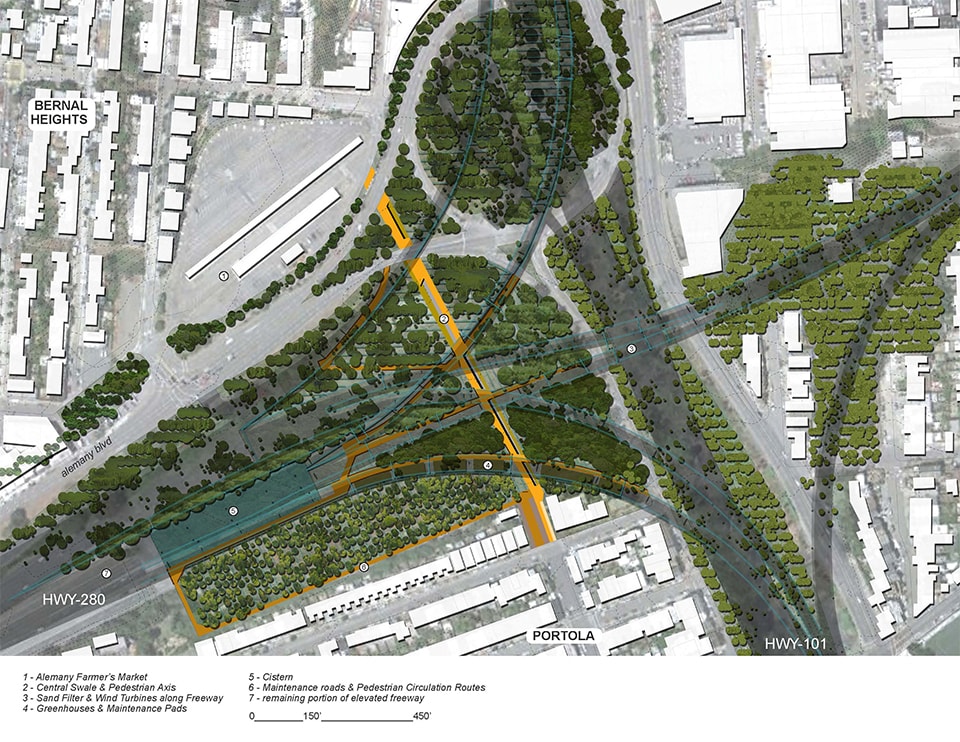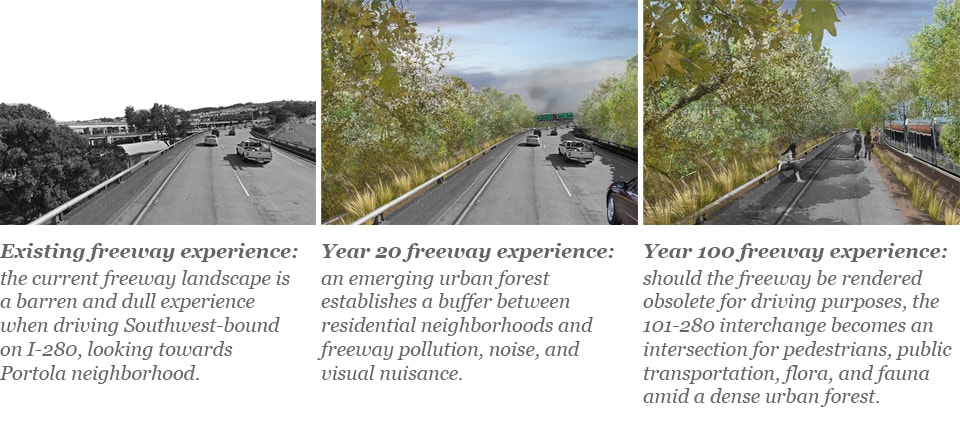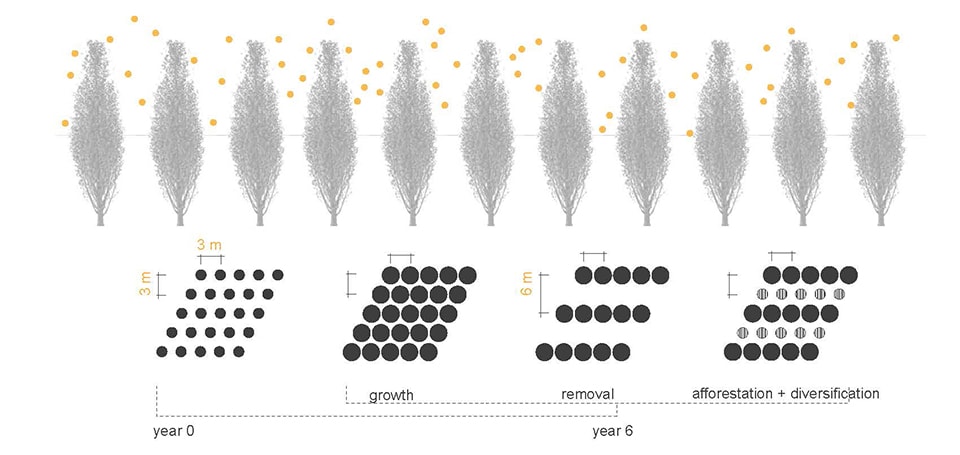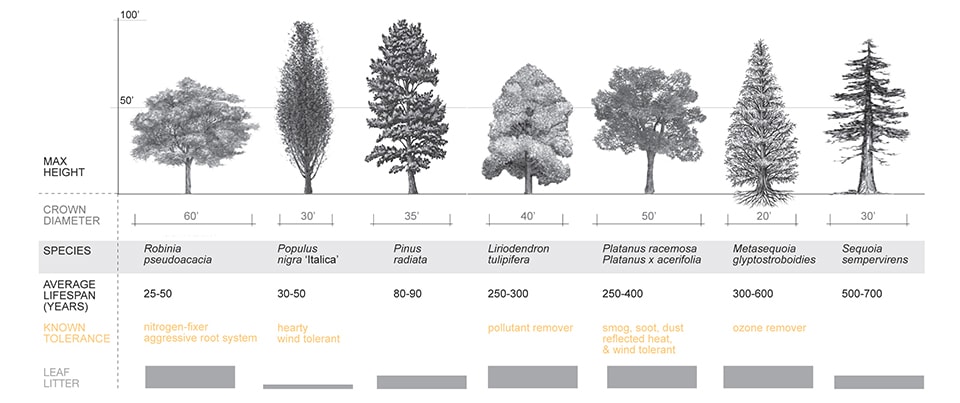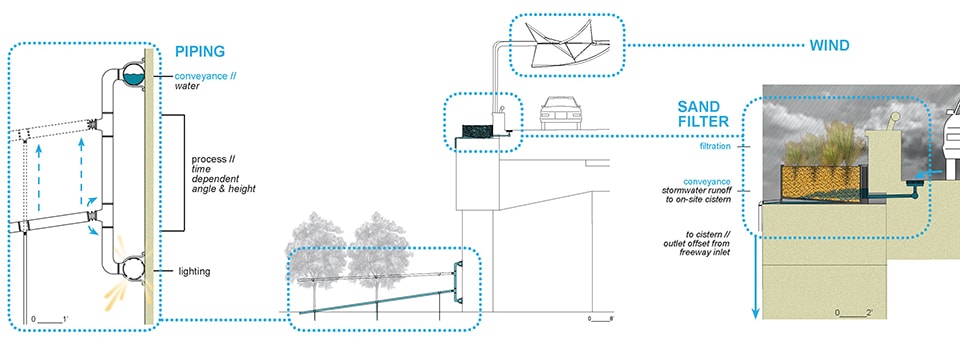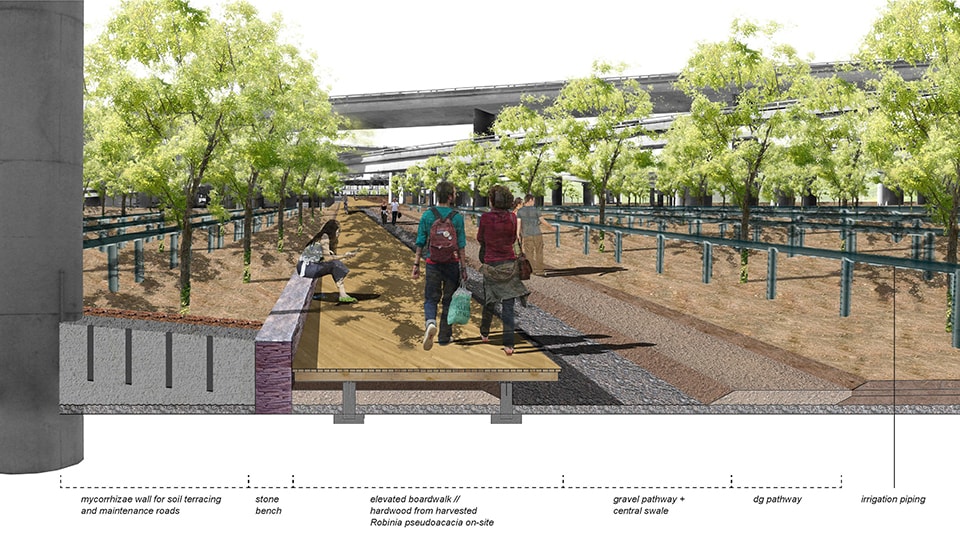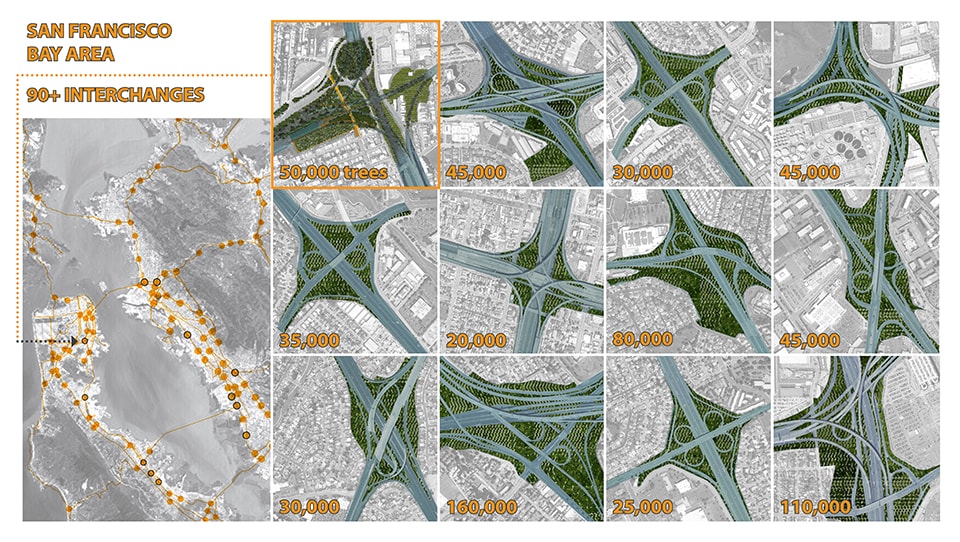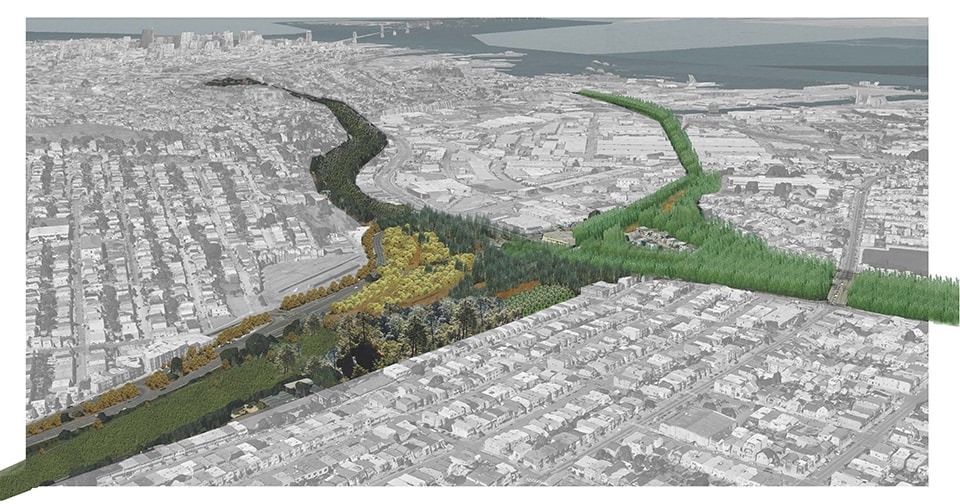Freeways and highway overpasses are often seen as the epitome of environmental destruction in the urban landscape. Yet the complex spaces below and around urban freeways could be productively re-imagined as beneficial working landscapes, deploying trees en masse to buffer the harmful effects of these traffic conduits. Consider that freeways emit copious amounts of Carbon Dioxide (CO2), while trees naturally sequester CO2. Many urban freeways possess neglected right-of-ways, while forests require space. This project explores how freeway urban forests could strategically offset a significant part of the city’s carbon emissions at the source.
As of 2012, 34.5 billion tons of Carbon Dioxide (CO2) were emitted annually worldwide [1]. The San Francisco Bay Area contributes 88 million tons annually [2]. Currently anticipating two million additional residents by 2040, the San Francisco Bay Area will face inflated emissions [3]. Recent studies suggest that densely planted urban forests can sequester CO2 to offset some of these emissions [4]. Urban forests also improve air quality, increase property values, provide enjoyable streetscapes, and establish buffers [5,6,7]. Freeway right-of-ways represent opportune land for locating sequestering forests in cities. They are some of the only remaining vacant land in the urban landscape, they are often underutilized, and many are adjacent to residential areas.
In this project, a 30-acre site of underutilized space beneath a multi-level interchange in San Francisco, CA is envisioned as a productive urban forest. The design for the site has three primary goals. First, it seeks to plant a robust forest of enough trees to partially offset annual CO2 emissions from the adjacent freeway. Second, it devises an irrigation system that builds upon existing infrastructure to irrigate the forest and to reduce persistent stormwater flooding on this former marshland. Third, it establishes pedestrian pathways and provides amenities throughout the forest to create a memorable and interactive landscape. The forest is envisioned as a new type of urban landscape that emerges over time, transforming the driving experience at the freeway level and establishing places for pedestrian interaction at street level. If the freeway is rendered obsolete in the future, the interchange would transition from a mono-functional freeway into a multi-use interchange for pedestrians, public transportation, flora, and fauna amid a dense urban forest.
Emerging Urban Forest: a 30-acre site of underutilized space located beneath a multi-level interchange in San Francisco, CA is envisioned as a highly productive sequestering urban forest of 50,000 trees that reduces storm water runoff and humanizes the street level, making it accessible, safe, and enjoyable for the public.
Emerging Carbon Forest
As an experiment in carbon sequestration, the project proposes to partially offset the yearly carbon emissions of the interchange within its footprint. CO2 emissions were calculated for the interchange using transit authority vehicle counts and average levels of annual emissions [8,9,10]. Within the expanse of the interchange, vehicles emit 1,040 metric tons of CO2 annually.
Research of contemporary forest sequestration techniques finds that an average mature tree can sequester 48 lbs of CO2 annually (or 0.0217 metric tons) [11,12,13,14].While studies suggest that carbon sequestration varies based on the species and age of the tree, the amount of carbon dioxide sequestered is directly related to the total biomass of a given tree [15,16,17]. Young and fast growing trees that rapidly accumulate biomass will uptake more CO2 than mature, slow-growing trees with limited annual growth [18]. Trees that possess large trunks, roots, branches, and leaves (respectively), those that are appropriate for the climate, and those that are coniferous or deciduous will also sequester increased amounts of CO2 [19]. Therefore, tree selection for the interchange includes eight rapidly growing trees known to thrive in San Francisco, including conifers and deciduous species with high levels of biomass [20]. The project utilizes this data for the site to estimate that an individual tree can sequester 48 lbs of CO2 annually.
Sequestering 1,040 tons of CO2 using an urban forest would therefore require 48,000 mature trees. If planted 12 feet apart, 300 mature trees can fit within a single acre and sequester 6.5 tons/acre of CO2 [21]. This planting regimen would require 160 acres to sequester all 1,040 tons of CO2.
Innovative planting methods have demonstrated that carbon sequestration can be done increasingly more efficiently than previously thought, making it feasible for small urban sites such as this one to play an important role in offsetting urban emissions. A study on biomass production and carbon sequestration potential in poplar plantations found that CO2 sequestration increases from 6.5 annual tons/acre to 30 annual tons/acre when specific planting and management strategies are used, such as planting trees 3 meters apart and cycling trees every 6 years [22]. The project’s design takes advantage of these innovative forest sequestration techniques, resulting in a cycling strategy that alternates phases of growth, partial removal, afforestation, and diversification. This compact planting and maintenance strategy allows for the sequestration of a portion of the 1,040 tons of CO2 and other emitted compounds within the available 30 acres rather than the otherwise required 160 acres.
Buffer & Grow
The I-280/HWY-101 freeway interchange is a multi-story structure spanning 1 mile in each direction. The freeway was built in the 1950’s with the sole purpose of rapid transportation, neglecting its context and surroundings. The massive structure divided residential neighborhoods that now line both sides of the interchange. It created narrow, dark, dirty, and dangerous sidewalks for pedestrian interchange at street level. For years, the freeway has subjected the neighborhoods to increased levels of emissions, noise, and neglect, perpetually decreasing real estate values and increasing asthma rates.
In addition, the interchange is located in a narrow valley and sits atop a former creek, slough, and extensive marshland. The waterways are confined to an underground culvert and are responsible for significant annual flooding. The valley is also known for extreme winds that billow across the interchange and are currently an untapped resource.
Today the freeway prevails as a mono-functional infrastructure that is destructive to its surroundings. In an era of growing populations, decreasing urban space, increasing emissions, and improving awareness of public health, we must re-design our infrastructure and available space to perform as a multi-purpose resource.
By employing an urban forest at the interchange, San Francisco would gain environmental and urban benefits on a range of scales. First, a vegetated buffer would emerge over time between the freeway and neighborhoods, absorbing sound and particulates. Second, walkways through the forest would improve connectivity and walkability between neighborhoods. Third, the devised catchment and irrigation system would mitigate annual flooding, reintroduce habitat to the area, and capitalize on available wind energy. Fourth, the forest would become a new open space for San Francisco that offers varied experiences and amenities not offered elsewhere in the city. With these improved conditions, property values of surrounding neighborhoods would likely increase. The estimated $1.7 million of annual city benefits generated at the interchange – including trees, soil, captured water, wind energy, and jobs – can then be used to expand the urban forest to least 90 other underutilized freeway right-of-ways throughout the entire San Francisco Bay Area [23]. Taken together, the resulting urban forest would become a “new and powerful” sequestration infrastructure functioning at the metropolitan scale.
Accumulating a Forest Over Time: an initial planting of Vicia faba — fava beans — rapidly increases nutrient soil accumulation to support the later stages of afforestation. Employing an intensive planting and maintenance regime, the forest emerges over 100 years and accumulates 50,000 trees.
Planting Strategies: Employing intensive forest management techniques that increases CO2 sequestration from 6.5 tons/acre to 30 tons/acre annually, [24] trees are planted 3 meters apart and cycled every 6 years through a process of growth, partial forest removal, afforestation, and diversification.
Tree Selection: species are selected based on their known pollutant-removing capabilities; their known ability to thrive in San Francisco; their rapid growth rate; and their large trunks, roots, branches, & leaves [25,26].
Water and Wind: The average urban tree requires 782 gallons of water per tree per year [27]. Overhead, thousands of gallons of stormwater accumulate on the freeway deck during rain events. This project proposes a multi-tiered regenerative catchment and irrigation system that latches to the existing freeway infrastructure. The stormwater is captured in a gravity-fed sand filter that runs alongside the freeway, filtering storm water from existing drains while directing the water into a sunken, on-site cistern. Wind turbines above the freeway capitalize on excessive valley winds to power pumps in the cistern that aerate the captured stormwater.
The Forest Floor: an elevated central boardwalk, constructed from trees grown on-site, promotes year-round access while the central swale accommodates a range of seasonal flooding, pedestrian experiences, and vantage points. Water is pumped from the sunken cistern through piping that extends across the forest floor. The piping is designed to move and adapt as the forest grows, and as soil and tree litter accumulate.
The System: While this project focused on one specific interchange, an emerging freeway forest could occur on at least 90 additional interchanges throughout the San Francisco Bay Area, creating a significant sequestration infrastructure at the metropolitan scale.
The Forest: applied to all freeway interchanges and right-of-ways throughout the city, a corridor of CO2-sequestering forests would emerge and serve as a buffer that promotes healthier, more attractive, livable cities.
The City of San Francisco has utilized the research, analysis, and design of this proposal to inform aspects of the recently released 2014 Urban Forest Master Plan for the City of San Francisco, Ca. The Urban Forest Master Plan is a component of the One Bay Area Plan that is aimed at offsetting emissions through innovative solutions.
This proposal received a 2013 National ASLA Honor Award in General Design.
Acknowledgements
The author would like to acknowledge Judith Stilgenbauer, Associate Professor of Landscape Architecture at University of Hawaii at Manoa School of Architecture, formerly at the University of California, Berkeley, with whom the project was conceived.
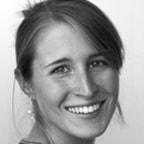 Sarah Moos is an Associate at Bionic, a landscape architecture and planning firm based in San Francisco, CA. The firm focuses on inventiveness in landscape projects at all scales as an agency for enabling life and stimulating culture in the modern conditions of the world today. Moos graduated with ASLA high honors from the University of California, Berkeley with two master’s degrees in Landscape Architecture and Urban Design. Her work combines critical analysis and urban scale thinking that strategically integrates landscape, ecology, infrastructure, and social factors in the public realm to activate underutilized urban space. Her work was recently recognized in the 2013 Samsung Everland Landscape Design Awards and the International Architectural Thesis Awards, emphasizing her critical analysis and urban scale thinking that strategically integrates landscape, ecology, infrastructure, and social factors in the public realm to activate underutilized urban space.
Sarah Moos is an Associate at Bionic, a landscape architecture and planning firm based in San Francisco, CA. The firm focuses on inventiveness in landscape projects at all scales as an agency for enabling life and stimulating culture in the modern conditions of the world today. Moos graduated with ASLA high honors from the University of California, Berkeley with two master’s degrees in Landscape Architecture and Urban Design. Her work combines critical analysis and urban scale thinking that strategically integrates landscape, ecology, infrastructure, and social factors in the public realm to activate underutilized urban space. Her work was recently recognized in the 2013 Samsung Everland Landscape Design Awards and the International Architectural Thesis Awards, emphasizing her critical analysis and urban scale thinking that strategically integrates landscape, ecology, infrastructure, and social factors in the public realm to activate underutilized urban space.

